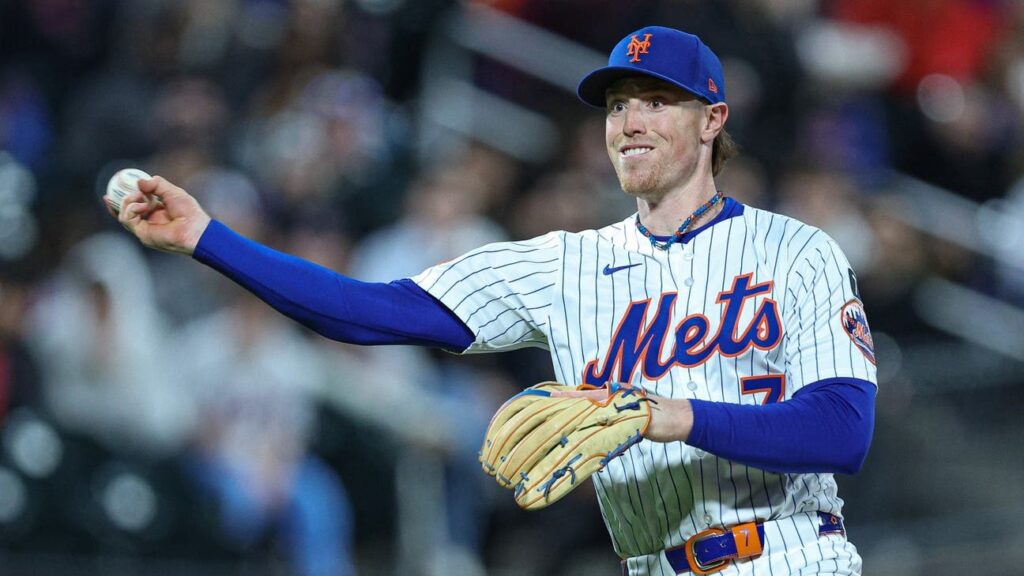When the Mets started talking last year about getting Brett Baty reps at second base, the rational response was … what? That Brett Baty? The bat-first corner guy? The one who does not seem to possess the tools of a middle infielder?
It felt like a classic case of a team floating a topic that it knew made little sense, but that it hoped rivals would notice enough to increase a player’s trade value.
In the offseason, when president of baseball operations David Stearns continued to praise Baty’s work at second, it seemed more of the same. The Mets weren’t actually planning to do this at the major league level, were they?
But then Jeff McNeil suffered an oblique injury during spring training. Nick Madrigal, the infielder who would have backed up McNeil, was already out for the season after separating his shoulder. That left Baty and Luisangel Acuña with an opportunity to split time filling in for McNeil.
A funny thing happened when reality met expectations. Baty ended up exceeding all internal and external projections for his defense. He utilized a strong work ethic and naturally quick first step to perform capably at second base. If he goes back to Triple-A on Friday, as seems likely with McNeil’s expected return, he will do so with increased value and versatility.
Similarly, Hayden Senger – a catcher who was long perceived to have a big league-caliber glove but perhaps the bat of an org-gut or non-prospect – has hit well enough during Francisco Alverez’s stint on the injured list to prove himself a viable MLB player.
Senger will also likely head to Syracuse prior to Friday’s game, but he will leave having added potential years to his professional career. That’s likely no exaggeration; now that Senger has shown that he belongs, he could break through as someone’s backup rather than wind down his career in the minors. For that matter, Luis Torrens proved he can be a starting catcher, which is why he’ll continue to see significant playing time after Alvarez returns on Friday.
Baty, of course, holds more significance to the franchise. A one-time top prospect, he has established a pattern of raking in spring training and at Triple-A and failing to control at-bats while with the Mets. He now finds himself blocked by Mark Vientos at third base.
Talk of Baty switching positions or serving in a utility role long seemed fanciful. Through no fault of his own, Baty was born with the broad lower half of a corner guy. Increasing his agility at third seemed a more reasonable goal.
But while Baty will never be as naturally slick and rangy at second as Acuña (who has earned a lasting place on the team) or Jose Iglesias, he left a deep impression on the Mets with his progress there. Just as Senger can survive at the plate in the big leagues, Baty has now shown that he can play a credible middle infield. Both he and the Mets staff, from Triple-A manager Dick Scott to major league infield instructor Mike Sarbaugh, deserve praise.
He has also validated the confidence that the Mets showed in him earlier this month. On April 9, Baty went 0-for-3 in a loss to Miami, striking out twice and hearing boos from the home fans. It seemed like a moment to consider optioning him to Triple-A, but the Mets did not seriously weigh it. Between that day and Tuesday of this week, Baty batted .280 with a .797 OPS.
On Wednesday, he homered when Zack Wheeler left a fat cutter over the plate, punishing the ball at 113.9 miles per hour. He also made a pair of slick plays and second on well-struck balls. If Baty goes down now instead of outfielder Jose Azocar, roster construction will be to blame, not the quality of his play.
This all means that, if Baty is forced to take another trip to Syracuse, it will be as a player enhanced by this stint in Queens, not diminished by it. Now the Mets – and perhaps as importantly, with Vientos emerging – other teams can view him as more versatile and attractive.
Read the full article here


